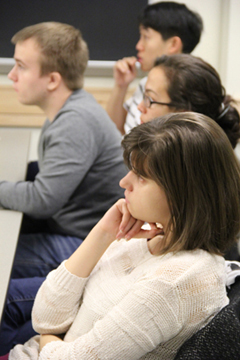Course Introduction
First-year graduate students in algebraic topology learn about homology, cohomology, and duality in their first semester, and basic homotopy theory, fibrations, classifying spaces, and characteristic classes during their second semester. But once students have learned this material, it can be challenging for instructors to convey to students something about the enormous amount of original research which builds on this basic curriculum. One strategy is to offer topics courses that address different aspects of the field’s development, but this approach is often somewhat fragmented. The Kan seminar, named after the late MIT professor, Daniel Kan, is an attempt to introduce students to the broad history of the subject.

Students listen as their colleague present a lecture on rational homotopy. (Photo courtesy of MIT OpenCourseWare.)
The first Kan seminar was held in the fall of 1969, and it has run nearly every fall since then. The charter class included:
- W. Stephen Wilson (Department of Mathematics and the School of Education, Johns Hopkins University)
- Dan Burns (Department of Computational Medicine and Bioinformatics, University of Michigan Medical School)
- Bruce Williams (Department of Mathematics, University of Notre Dame)
- Tadatoshi Akiba (Mayor of Hiroshima from 1999 to 2010)
- Hans Anton Salomonsen (Department of Mathematics, Aarhus University)
- Ken Brown (Department of Mathematics, Cornell University)
Learning Objectives
The objective of the Kan Seminar is to acquaint students with some of the classic papers in algebraic topology. More broadly, it provides experience and training in how to read a research paper. These papers are difficult, often long, and, as original sources, they sometimes embody what seems today like a peculiar perspective. The students learn to focus on critical arguments and ideas and distill them to an essence that can be presented in one 50-minute lecture. The seminar also develops student’s ability to scan an article quickly, to glean the essential points and relate them to the rest of their evolving intellectual infrastructures, and to express this understanding.
But there are hidden objectives as well. Students in the Kan Seminar spend a lot of time together, explaining things to each other and trying to puzzle things out. Trust and the habit of working together greatly enhance the graduate student experience, and this subject is designed to encourage the development of these characteristics. The seminar builds a community that will stay together as the students advance through their graduate program. It also provides a basis for a lasting relationship between the participants and the seminar leader. Students are encouraged to talk with other faculty about the paper they are currently working on; this provides a useful entree. It’s very important that it not be perceived as a recruiting tool for the seminar leader or even for the subject.
MIT alumnus, Philip Hirschhorn, participated in the Kan Seminar under the leadership of Daniel Kan. He notes:
I think the most important function of the Kan Seminar was to push students through the transition from someone who takes courses to someone who thinks more actively about mathematics. You had to make sense of what had been done in those seminal papers, and try to explain that to other students (and to Dan, who was a very critical audience). Speaking in that seminar was a somewhat terrifying experience for most of us, which is why Dan never allowed visitors; if the speaker felt stressed and embarrassed, at least it was only in front of others going through the same thing.
As the end of the semester approached, Dan would start pressuring everyone to take their orals as soon as possible, to get them out of the way so that you could start getting work done. A standard argument that Dan would have with everyone was that he’d pressure you to start work on something, and you’d complain that you didn’t know nearly enough yet and needed to take more courses first. Dan would insist that you knew enough to get started, and that you’d learn what you needed when you found you needed it, and that you’d probably learn it much more thoroughly.
The seminar was essentially required for all grad students in any field close to topology. This was partly because it had such a maturing effect, and partly because it was recognized that Dan didn’t use the seminar to recruit students for himself, or even topology. He very strongly wanted to get people working, in whatever direction their interests led.
Site Introduction
This course site is intended for educators interested in teaching the Kan Seminar in algebraic topology or related field. It is built upon descriptions and commentary from Professor Haynes Miller, the instructor of the Fall 2014 offering of the course. Content has been divided into the following sections, which can be accessed via the navigation panel along the left side of this page: Life and Teaching of Daniel Kan; Course Logistics; Calendar; Reading List; Practice Talks, Feedback after Talks, Reading Responses, Rewards for Educators, and Kan Seminars Beyond MIT.










